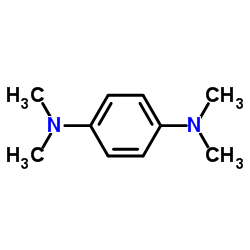637-01-4
| Name | N,N,N',N'-Tetramethyl-p-phenylenediamine dihydrochloride |
|---|---|
| Synonyms |
1-N,1-N,4-N,4-N-tetramethylbenzene-1,4-diamine,dihydrochloride
MFCD00012482 N,N,N',N'-Tetramethylbenzol-1,4-diamindihydrochlorid 1,4-Benzenediamine, N,N,N,N-tetramethyl-, hydrochloride (1:2) Wurster's reagent dihydrochloride N,N,N',N'-Tetramethyl-P-phenylenediaminedihydrochloride 1,4-Benzenediamine, N,N,N',N'-tetramethyl-, dihydrochloride N,N,N',N'-Tetramethylbenzene-1,4-diamine dihydrochloride N,N,N',N'-Tetramethyl-1,4-benzenediamine dihydrochloride EINECS 211-274-8 |
| Description | TMPD dihydrochloride, a readily oxidizable compound, is an enzymatically convert redox active substrate molecule. TMPD dihydrochloride is also an electron donor and serves as a reducing cosubstrate for heme peroxidases[1][2]. TMPD dihydrochloride is also a complex IV substrate[3]. |
|---|---|
| Related Catalog | |
| In Vitro | TMPD (N,N,N′,N′-tetramethyl-para-phenylene-diamine) is used in cell culture and microbiology to differentiate organisms that exhibit cytochrome c oxidase activity and to distinguish between Gram-negative and Gram-positive pathogenic and non-pathogenic bacteria. The concept of TMPD oxidation by microorganisms is widely used and is known as a successful colorimetric indicator for bacterial oxidases, as the radical cation TMPD+˙, formed by oxidation, shows a characteristic deep blue colour. The electrochemical recognition of the TMPD oxidation by bacterial oxidases can be applied to a variety of pathogens[1]. |
| References |
| Boiling Point | 260.6ºC at 760 mmHg |
|---|---|
| Melting Point | 222-224 °C(lit.) |
| Molecular Formula | C10H18Cl2N2 |
| Molecular Weight | 237.169 |
| Flash Point | 104.9ºC |
| Exact Mass | 236.084702 |
| PSA | 6.48000 |
| LogP | 3.42260 |
| Storage condition | Store at RT. |
| Stability | Stable. Incompatible with strong oxidizing agents, strong bases. |
| Water Solubility | SOLUBLE |
| Symbol |

GHS07 |
|---|---|
| Signal Word | Warning |
| Hazard Statements | H315-H319 |
| Precautionary Statements | P305 + P351 + P338 |
| Personal Protective Equipment | dust mask type N95 (US);Eyeshields;Gloves |
| Hazard Codes | Xn:Harmful; |
| Risk Phrases | R20/21/22 |
| Safety Phrases | S26-S36-S36/37 |
| RIDADR | 2811 |
| WGK Germany | 3 |
| Packaging Group | II |
| Hazard Class | 6.1(a) |
| HS Code | 29215190 |
|
~% 
637-01-4 |
| Literature: Journal of Physical Chemistry, , vol. 95, # 16 p. 6218 - 6227 |
| HS Code | 2921519090 |
|---|---|
| Summary | 2921519090. o-, m-, p-phenylenediamine, diaminotoluenes, and their derivatives; salts thereof. VAT:17.0%. Tax rebate rate:17.0%. . MFN tariff:6.5%. General tariff:30.0% |
